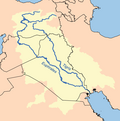External links
Wikimedia Commons has media related to History of Baghdad .
- "History of Baghdad". University of Baghdad.
- Yezin Al-Qays (ed.). "Heart of Baghdad".
- "Movie Theaters in Baghdad, Iraq". CinemaTreasures.org. Los Angeles: Cinema Treasures LLC.
- Harold W. Morgan (1917–1919). "Photograph album of Capt. W. Harold Morgan: Mesopotamia". (includes photos of Baghdad)
- Europeana. Items related to Baghdad, various dates.
33°19′30″N44°25′19″E / 33.325°N 44.422°E / 33.325; 44.422
| Countries | ||
|---|---|---|
| Cities | ||
| Tributaries |
| |
| Dams | ||
| East |
| |
|---|---|---|
| West | ||
| Suburban | ||
| 20th century | |
|---|---|
| 21st century | |


